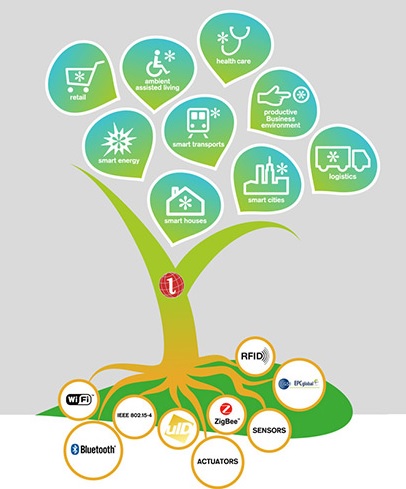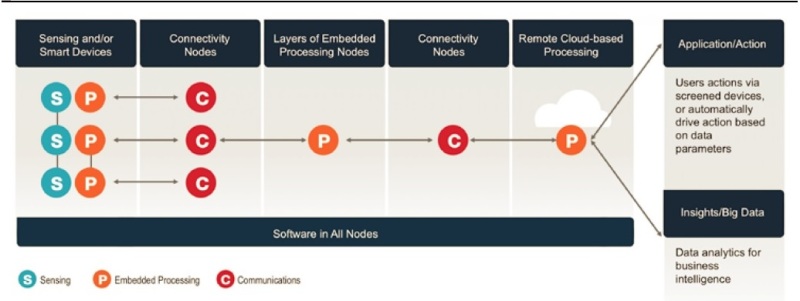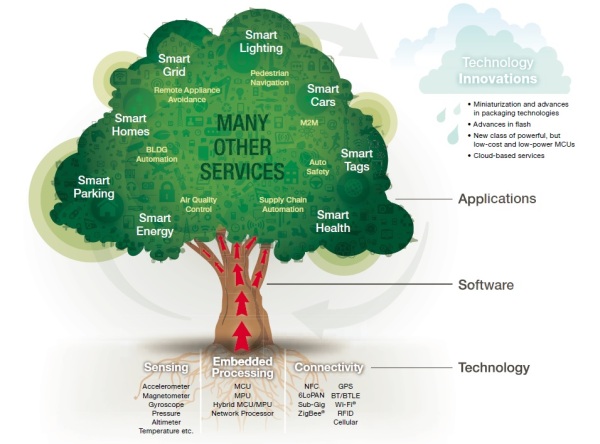Every generation is said to tune into current vibration levels and raise it higher for evolution. Evolution of both technology and human life is marked by greater finesse, vividness and presence, all of it driven by evolution of thought. The concept of ‘Internet of Things’ (IoT) is an inspiring vision to bring together innumerable technology advancements in computing & communications, and further evolve those through innovation, to improve quality of human life by interconnecting physical and cyber worlds. High-profile IoT applications include Industrial Control, Home Automation, Smart Retail, Connected Health, Hi-tech Cities, Intelligent Transportation and Logistics .
Figure – IoT Applications (Source: IoT-A)
Per Business Insider Intelligence [refer figure below], Internet of Things will connect devices in never-seen-before scale and at a faster pace than the industry has witnessed so far with PCs/smartphones/tablets, or in the future with wearables. And so the challenge in bringing alive Internet of Things – which is estimated to connect over 50 Billion devices by 2020, in a world populated today with 7.2 billion people & growing a little over 1% – is to make possible connecting devices cost-effectively and efficiently in whopping scale, and in an open world by addressing security needs and alleviating privacy concerns.
Figure – Growth trend & forecast for connected devices (Source: Business Insider)
How IEEE defines Internet-of-Things
Having set out to understand technology demands from IoT, let’s start with a technical definition of the key term. Here is how the IEEE IoT technical community defines it. “The Internet of Things (IoT) is a self-configuring and adaptive system consisting of networks of sensors and smart objects whose purpose is to interconnect “all” things, including everyday and industrial objects, in such a way as to make them intelligent, programmable and more capable of interacting with humans.”
While SDOs (Standard Development Organizations) use the phrase Internet-of-Things/IoT, vendors have coined different terms – ranging Internet-of-Everything (Cisco – Refer my previous article for IoE definition), Industrial Internet (General Electric), Smart & Connected Communities (Cisco’s Smart Cities solution), Smart Planet (IBM) – with either wider or limited scope given their industry play and applicable market segments.
IoT – Key Architectural Layers
Here is a simplified view of technology components that are needed to actualize IoT. To reiterate, IoT is a system formed of “enabling” technologies, and not a specific set of technologies per se.
Figure – Functional View of IoT Technologies (Source: Freescale.com)
Given that multi-service edge connectivity nodes have embedded processing capability, we could aggregate two or more of the building blocks, in the above functional view. Thus, the key layers in the IoT architecture, as exemplified in ITU-T’s IoT reference model below in a more granular manner, are:
- Sensor/machine infrastructure
- Communication backbone
- M2M service layer
- Application platform
In addition, we have critical overlay functions – Security and Management – that span multiple layers.
Figure – IoT Reference Model (Source: ITU-T)
IoT Technology demands
Let’s now delve into the technology demands of IoT from each of its architectural layers.
The Sensor/Machine Infrastructure layer is formed of sensors, actuators and smart objects that would help onboard the physical world into Internet-of-Things.
| Sensor/Machine Infrastructure Layer – Characteristics, Challenges & Technology demands |
|
The Communication Backbone comprises of M2M gateways, multi-service edge and backbone IP/MPLS core nodes, which form the network infrastructure and connect things globally. M2M gateways play a vital role in this architecture as they, along with edge nodes with fog computing capability (i.e. those with compute, storage and network resources between sensors and clouds), aggregate information from innumerable directly-connected endpoint devices with varying compute/memory/network-connectivity capabilities.
| Communication Backbone – Technology demands of boundary nodes |
|
The M2M Service Layer, a software layer between transport and application protocol layers, will provide data transport, security, device discovery and device management across a multitude of vertical domains, independent of communication technologies in the lower layers. This will help ensure connectivity between devices and various M2M applications, to realize horizontally integrated Internet-of-Things, as against vertical silos or ‘Intranet-of-Things’ for specific applications. This layer should ensure semantic modeling of things by providing context for the information that “things” can provide, or actuations they can perform. For e.g., while providing data from a temperature sensor for home automation, it should also describe if it is the indoor temperature of a room, or the temperature of a fridge etc.
The IoT Application Platform, powered by transformative technologies such as Cloud and Big Data Analytics, will host IoT applications for global users.
The result of such a layered architecture is a globally accessible network of things, providers and consumers, who can create businesses, contribute content, generate and purchase new services.
Figure – IoT Applications with ‘enabling’ technologies (Source: Freescale.com)
While connectivity devices and technologies have existed for long, each of the discussed components in the IoT architecture will need to go through one or more evolution phases, until it passes the following two key litmus tests, which drive the need for innovation and eventually standardization.
- Is it technically & economically effective and efficient for IoT scale?
- Can it handle the implications of operating in an open world?
So, let’s take a look at industry efforts around innovation and standardization, in the next section.
IoT – Interoperability through Standards & Collaboration
With IoT predicted to create roughly $15 trillion in value-at-stake over the next 10 years, we have just about every vendor exploring market adjacencies to tap into this market potential. About 66% of the total value i.e. $9.5T is forecast to come from specific industry verticals (e.g. Smart Grid, Connected Healthcare), while the remaining 34% or $4.9T would be derived horizontally across industries (e.g. knowledge-worker productivity, travel avoidance). This has prompted vendors to form alliances among themselves, and with SDOs to drive vertical specific and cross-industry innovations/standardizations as applicable.
While standards bodies are effective at reaching multi-stakeholder consensus, and are efficient in comparison to letting market pick winners and losers among alternative technologies, industry-led consortia are comparatively faster, adaptive to market conditions and allow dominant players to push forward their interests. Cross-industry collaboration could also help quicken the pace of IoT adoption by increasing affordability through economy of scale benefits, and enable future applications as yet unimagined.
Below is a snapshot of the heterogeneous standards environment in IoT, as of a couple of years ago. Since then, the ecosystem has seen more protocol innovations – ModBus, IEEE WAVE 1609.2, Deterministic Ethernet, Power line communication (IEEE 1901 and IEEE 1901.2), Ultra-Wide Bandwidth (UWB) Technology to name a few – and thus further increasing heterogeneity. However vendors and SDOs are involved in concerted efforts, to bring in interoperability among architectural layers and across IoT applications spanning industry verticals, to address this dire challenge in realizing the vision of Internet-of-Things.
Figure – Heterogeneous standards environment in IoT (Source: IoT Research EU)
Let’s now go over various working groups that have sprouted in the IoT space, to supplement technology innovation and interoperability efforts from SDOs such as ITU-T, ETSI, IEEE and IETF typically focused on specific OSI layers, or drive joint standards across SDOs.
| Working Group (Active Since) | Charter | Founding Members |
|
IPSO Alliance (Sep 2008) |
Establish Internet Protocol (IP) as the network to interconnect smart objects, and allow existing infrastructure to be readily used without translation gateways or proxies | ARM, Atmel, Bosch, Cooper, Dust Networks, EDF, Ericsson, Freescale et al |
|
IoT-A (2010-2013) |
Developed an architectural reference model to allow seamless integration of heterogeneous IoT technologies into a coherent architecture to realize ‘Internet of Things’ rather than ‘Intranet of Things’ | ALU, Hitachi, IBM, NEC, NXP, SAP, Siemens, and universities – “Mission Accomplished late 2013” |
|
oneM2M (2012) |
Develop technical specifications for a common M2M Service Layer to allow connectivity between devices and various M2M applications, to realize horizontally integrated Internet-of-Things | Leading ICT standards bodies namely ETSI, ARIB, TTC, ATIS, TIA, CCSA and TTA |
|
AllSeen Alliance (2013) |
Collaborate for an open, universal IoT software framework across devices and industry applications, based on AllJoyn open source project, originally developed by Qualcomm but now released to community developers | Qualcomm, in collaboration with Linux Foundation |
|
Industrial Internet Consortium (Mar 2014) |
Accelerate development and adoption of intelligent industrial automation for public usecases | AT&T, Cisco, GE, Intel, IBM |
|
HomePlug Alliance (Apr 2014) |
Develop technology specs for powerline networking to enable home connectivity | AMD, 3Com, Cisco, Intel, Intellon, Texas Instruments, Motorola, Panasonic at al |
|
HyperCat (May 2014) |
Develop an open specification for IoT that will make data available in a way that others could make use of it, through a thin interoperability layer. | ARM, BT, IBM, Intel, Living PlanIT, et al |
|
Open Interconnect Consortium (Jul 2014) |
Define interoperable device communication standards (for peer-to-peer, mesh & bridging, reporting & control etc.) across verticals, and provide an open source implementation | Atmel, Broadcom, Dell, Intel, Samsung and Wind River |
|
IEEE P2413 (Jul 2014) |
Create a standard interoperability architecture and define commonly understood data objects, for information sharing across IoT systems; Standardization targeted by 2016 | IEEE; collaborating with oneM2M, ETSI and other SDOs to evolve joint standards |
|
Thread (2014) |
Create an open, secure, simple, power-efficient protocol, based on robust mesh network that runs over standard 802.15.4 radios, and can support a wide variety of home products | ARM, Freescale, Nest, Samsung, Silicon Labs, Yale |
|
OMA LWM2M (2014) |
Proposed a new Light-weight M2M protocol standard, based on client-server model for remote management of M2M devices and related service enablement | OMA |
I haven’t included Apple’s HomeKit & HealthKit software platforms though the company has inducted home/health device manufacturing partners, as it wasn’t really a consortium led effort.
As can be observed in the above table, many more vendors have come together in 2014 and formed new consortia, with well-defined charters even if overlapping ones. The developments so far have been encouraging, given that the ecosystem has been able to drive protocol innovations (e.g. IEEE 802.15.4, LWM2M, HyperCat, etc.), arrive at an all-encompassing IoT reference architecture (IoT-A), identify the need for an M2M Service Layer (oneM2M) and hopefully many more that I’m not aware of, as yet.
Are things looking up for IoT?
Let me wrap up the post with my key takeaways, from this analysis on IoT technology demands and developments.
Given that multiple protocols have always existed in each layer of the OSI stack, it is not realistic to expect the ecosystem to converge on a single protocol standard for each layer in the IoT reference model, considering varied applications needs and diverse physical operating conditions for connected devices. However, basic IoT requirements such as humungous scale, strong security safeguards and lightweight remote management of devices will demand that protocols in each layer be evolved or revamped. Consortia led efforts such as those from Thread, HomePlug, HyperCat and OMA LWM2M that drive focused innovations, keeping in mind the need to ease migration or ensure compatibility with existing protocol standards and other IoT advancements, should help quicken the pace of IoT evolution.
On the technology standardization/innovation front, the pace of development has been assuring [as I’ve elaborated in the previous section]. There certainly aren’t any tangential efforts or cases of SDOs locking horns that could potentially dampen IoT technology development. On the contrary, multiple interop events are being jointly organized to evolve IoT specifications, especially around IoT architecture and its critical M2M Service Layer to accommodate IoT applications spanning industry sectors.
There is certainly lot more for me to dig into on the IoT front, be it developments in sensors/actuators/smart objects, IoT gateways & controllers, communication protocols, security or management aspects. Now that we’ve figured out how to make sense of the Internet-of-Things world, what we know about it and what we don’t, let’s learn more on IoT aspects that interest us and redefine the coordinates of IoT, some another day.
Until then, if you have any views on my post that could help me reconstruct Internet-of-Things better, please share those in the comments section.
- 3GPP
- 6LoWPAN
- actuators
- AllSeen Alliance
- Bluetooth low energy
- CoAP
- Deterministic Ethernet
- HomePlug Alliance
- HyperCat
- IEEE 1901
- IEEE 1901.2
- IEEE P2413
- IEEE WAVE 1609.2
- Industrial Internet
- Industrial Internet Consortium
- Internet of Everything
- Internet of Things
- IoE
- IoE technology
- IoT
- IoT architecture
- IoT controllers
- IoT gateways
- IoT innovation
- IoT standards
- IoT technologies
- IoT technology demands
- IoT-A
- IPSO Alliance
- Linux Foundation
- M2M service layer
- ModBus
- NFC
- OMA LWM2M
- oneM2M
- Open Interconnect Consortium
- Power line communication
- Qualcomm
- RPL
- Sensor/machine infrastructure
- sensors
- smart objects
- Smart Planet
- Thread
- Ultra-Wide Bandwidth
- UWB
- ZigBee






Reblogged this on The Embedded Code.